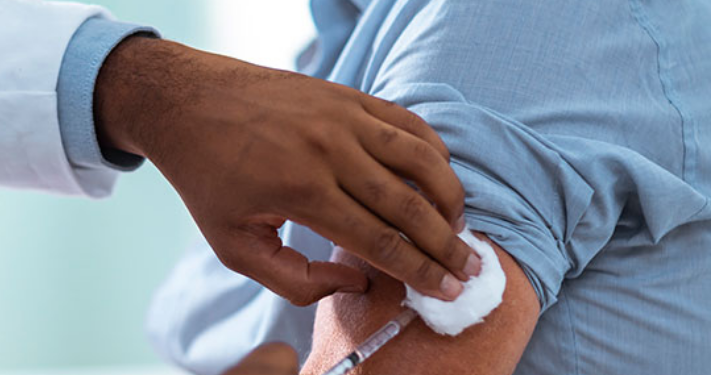
- Details
- By Native News Online Staff
ROCKVILLE, Md. — The Indian Health Service (IHS) on Thursday released the IHS COVID-19 Pandemic Vaccine Plan November 2020. The 42-page plan details how the IHS health care system will prepare for and distribute a vaccine for the deadly COVID-19 disease.
The plan includes important guidance for all IHS federal, tribal health programs, and urban Indian organizations that choose to receive the COVID-19 vaccine coordinated through IHS.
“IHS COVID-19 Pandemic Vaccine Plan is laying the necessary groundwork for the distribution of a safe and effective COVID-19 vaccine,” said IHS Director Rear Adm. Michael D. Weahkee. “We’ll ensure that safe and effective vaccines can reach Indian Country as quickly and equitably as possible.”
The plan is based on currently available IHS information. The agency will continue to assess, respond, and adapt federal guidance as new information becomes available regarding vaccine developments, vaccine storage requirements, risk groups, and prioritization recommendations by researchers and advisory bodies.
The plan incorporates suggestions through tribal consultation to seek input from tribal leaders on COVID-19 vaccination planning for Indian Country. IHS also initiated tribal consultation and urban confer in October to seek input from tribal and urban leaders on the IHS COVID-19 Pandemic Vaccine Draft Plan.
Indian Country has been disproportionately impacted by the pandemic. Among American Indians and Alaska Natives the infection rate is over 3.5 times higher than non-Hispanic whites. American Indians and Alaska Natives are over four times more likely to be hospitalized as a result of COVID-19.
As with the rest of the country, up until the pending introduction of a vaccine to ward off the coronavirus, social distancing, mandatory curfews and closures, mask-wearing and handwashing have been the most effective remedies in Indian Country.
According to the plan, it is anticipated initial FDA approved COVID-19 vaccines will be two-dose series, separated by 21 to 28 days. If more than one brand is approved, the two doses must be of the same brand. Current recommendations are to fully vaccinate initial populations before expanding to additional populations.
Similar to what is proposed for the national vaccine distribution, the IHS plan calls for the most vulnerable to receive the vaccine first. Included in this critical part of Indian Country are:
- Healthcare personnel (direct, non-direct, and emergency medical services) – the number of people included is 43,783
- Essential workers (other emergency services, law enforcement, food and transportation, teachers, childcare providers) – the number of people included is 120,671
- Patients in tribal long-term care facilities – the number of people included is 76,311
- Elders – the number of people included is 374,411
- Patients at high-risk factors for COVID-19 illness – the number of people included is 894,260
The IHS plan calls for a total of 2,056,347 (figures as of Nov. 16, 2020) to be vaccinated.
IHS developed the COVID-19 Vaccine plan based on the Centers for Disease Control and Prevention’s COVID-19 Vaccination Interim Playbook for Jurisdiction Operations, while recognizing the sovereign authority of tribal nations to provide for the welfare of their people. IHS reached out to tribes and urban Indian organizations for their involvement in planning efforts. Each tribe and urban Indian organization provided its preference for COVID-19 vaccine distribution (IHS or state distribution) to ensure the vaccine is effectively delivered to Indian Country.
To learn more about Indian Health Service’s support for the nationwide COVID-19 response, visit ihs.gov/coronavirus.gov.
Correction: A previous version of this article mistakenly said "Young healthy adults in Indian Country are not included in this plan." They are included.
More Stories Like This
Native News Weekly (August 25, 2024): D.C. BriefsUS Presidents in Their Own Words Concerning American Indians
Suspected Drunk Driver Crashes into Parade in Kayenta on Navajo Nation, Killing 1 & Injuring 3 Others
Tribal Broadband to Get $6.5M Boost as NTIA Plans Consultations
Pokagon Potawatomi Band, Four Winds Casinos Donate 1,000 Christmas Food Boxes
Help us defend tribal sovereignty.
At Native News Online, our mission is rooted in telling the stories that strengthen sovereignty and uplift Indigenous voices — not just at year’s end, but every single day.
Because of your generosity last year, we were able to keep our reporters on the ground in tribal communities, at national gatherings and in the halls of Congress — covering the issues that matter most to Indian Country: sovereignty, culture, education, health and economic opportunity.
That support sustained us through a tough year in 2025. Now, as we look to the year ahead, we need your help right now to ensure warrior journalism remains strong — reporting that defends tribal sovereignty, amplifies Native truth, and holds power accountable.
 The stakes couldn't be higher. Your support keeps Native voices heard, Native stories told and Native sovereignty defended.
The stakes couldn't be higher. Your support keeps Native voices heard, Native stories told and Native sovereignty defended.
Stand with Warrior Journalism today.
Levi Rickert (Potawatomi), Editor & Publisher

